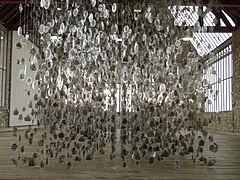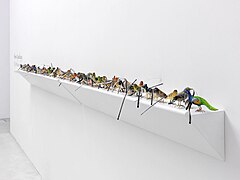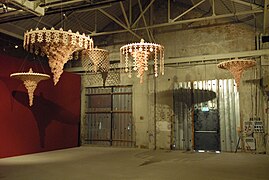Hema Upadhyay
Hema Upadhyay | |
|---|---|
| Died | 11 December 2015 (aged 42–43) |
| Education | BFA in painting and MFA in print making from Maharaja Sayajirao University of Baroda, 1997 |
Hema Upadhyay (born Hema Hirani; 1972 – 11 December 2015) was an Indian artist based in Mumbai. She was known for photography and sculptural installations. She was active from 1998 until her death in 2015.
Personal life
Born Hema Hirani in
Early works
Hema had her first solo exhibition, titled Sweet Sweat Memories, at Gallery Chemould, now Chemould Prescott road (Mumbai), in 2001. The exhibition consisted of mixed media on paper works. In these works she has incorporated her own photographs to communicate her ideas of migration having moved to Bombay in 1998. Hema's paintings were usually characterised by the inclusion of small-collaged photographic self-portraits.
-
The Nymph and the Adult, Installation, 2001, Artspace, Sydney, Australia
-
Made in China, Collaborative installation, 2003, Gallery Chemould, Mumbai, India
In 2001 Hema had her first international solo at
In collaboration with
Museum exhibitions
From 2004 onwards, Hema Upadhyay came up with installations that were part of various group shows at the Ullens Center for Contemporary Art Beijing, China; National Portrait Gallery Canberra, Australia; Centre Pompidou, Paris, France; Museum on the Seam, Jerusalem, Israel; MACRO museum, Rome, Italy; IVAM, Valencia, Spain; Mart Museum, Italy; Mori Art Museum, Tokyo, Japan; Hanger Bicocca, Milan, Italy; Chicago Cultural Centre, Chicago, USA;
-
8' x 12', 2009, installation, Indian Highway
-
Where the bees suck, there suck I, 2009, MACRO Museum, Rome, Italy
-
Think left, think right, think low, think tight, 2010, Aichi Triennial, Nagoya, Japan & Centre Pompidou, Paris, France, 2011
She was the only Indian artist to be part of the inaugural exhibition for the Reopening of the MACRO museum, Rome. The exhibition was curated by Luca Massimi Barbero, Hema exhibited her installation titled Where the bees suck, there suck I.
Residencies and workshops
In 2010, Hema was invited to a residency at Atelier Calder, Sache, France. While there, she completed the work Only Memory has Preservatives, this work was inspired by the natural surroundings in Sache, but also reflected ideas that have been part of her practice. Hema tried to replicate the forest in her studio, though not in the literal sense. Using copyright free images of certain trees found in the area, she created a landscape work without using materials from nature.
In 2003 she was part of the Vasl residency in
Her later works featured patterned surfaces, which quote from Indian spiritual iconography and traditional textile design, titled Killing Site. Dream a wish-wish a dream (2006) was the first large-scale installation that Hema did. At first glance her installation seems to be only a landscape of Bombay; however, it is actually a statement on the changing landscape by migrants who make Bombay.
-
Only Memory has Preservatives, 2010, Atelier Calder, Sache, France
-
Moderniznation, 2011, Espace Topographie de l'Art, Festival D' Automne a Paris, Paris, France
-
The Princesses' Rusted Belt, 250 handmade clay birds, iron wire, acrylic, watercolours, cotton thread and text on printing paper, dimensions variable, 2011, Studio La Citta, Verona, Italy
-
The Princesses' Rusted Belt, Mixed media on arches paper, 72 x 48 in, 2011, Studio La Citta, Verona, Italy
-
Loco foco motto, 2007, Hanger Bicocca, Milan, Italy
-
Killing Site, 2008, Studio La Citta, Verona, Italy
-
Dream a wish-wish a dream, 2006
Selected solo presentations
- 2012 Extra Ordinary, Faculty of Fine Arts Baroda, and Vadehra Art Gallery, New Delhi
- 2012 Mute Migration, Art Gallery of New South Wales, Sydney, Australia
- 2011–12 Princesses Rusted Belt, Studio La Citta, Verona Italy (Ex Cat)
- 2011 Moderniznation, Espace Topographie de l'Art, Festival D' Automne a Paris, Paris
- 2009 Where the bees suck, there suck I, Reopening of MACRO museum, Rome Italy
- 2008–09 Yours Sincerely, Gallery Nature Morte, New Delhi
- 2008 Universe revolves on, Singapore Tyler Print Institute, Singapore (Ex. Cat)
- 2004 Underneath, Gallery Chemould, Bombay (Ex. Cat)
- 2001–02 The Nymph and the Adult, Institute of Modern Art, Brisbane (Ex. Cat)
- 2001 Sweet Sweat Memories, Gallery Chemould, Bombay (Ex. Cat)
- 2001 The Nymph and the Adult, Art Space, Sydney
Select Group Shows
Source:[4]
- 4th International Print Biennale, Bharat Bhavan, Bhopal, 1997
- Prithvi Art Gallery, Mumbai, 1998
- Secret Life of Objects, Lakeeran Gallery, Mumbai, 2000
- Exchanging Territories, Shridharani Gallery, New Delhi, 2001
- X International Triennale, Lalit Kala Academi, New Delhi, 2001
- Transfiguration, Art Inc, India Habitat Center, New Delhi, 2002
- crossing generations: diVERGE, Gallery Chemould, Mumbai, 2003
- Loco-Foco-Motto, a sculpture made with match sticks, International Artists' Residency, Karachi, Pakistan, 2003
- Parthenogenesis, Ivan Dougherty Gallery, Sydney, Australia, 2003
- The Tree from the Seed, Hennie Onstad Kunssenter, Oslo, Norway, 2003
- Have We Met, Japan Foundation Forum, Tokyo, Japan, 2004
- Indian Summer: Ecole Nationale Superieure des Beaux Arts, Paris, 2005
- Indian Contemporary Art, Chelsea college of Art, London, 2005
- Present Future, NGMA, Mumbai, 2005
- Parallel Realities-Asian Art Now, The 3rd Fukuoka Asian Art Triennale, Blackburn Museum, Blackburn, UK, 2006
- Long Happy Hours and Thereby Happiness and Other stories, the Museum Gallery, Mumbai, 2006
Invited as artist in residence
- 2010 Atelier Calder, Sache, France
- 2008 Singapore Tyler Print Institute, Singapore
- 2007 Mattress Factory, Pittsburgh, USA
- 2003 Vasl International Artists Residency, Karachi
- 2001 Art Space, Sydney
Death
Hema Upadhyay and her lawyer Haresh Bhambani were killed on Friday, 11 December 2015, reportedly over a financial dispute.
Bhambhani had represented Hema in court cases against her ex-husband Chintan. After filing for a divorce in 2010, Chintan and Hema had lived in different rooms of their Mumbai flat until their divorce in 2014. In 2013, Hema had filed a harassment case against Chintan, accusing him of painting obscene sketches on the walls of their Mumbai flat.[7] Represented by Bhambhani, she lost the case after the court ruled that Chintan's bedroom was his personal space.[1] After their divorce, Chintan moved to Delhi. Bhambani represented Hema in another case seeking alimony: Hema demanded an alimony of ₹ 200,000 per month; but the court reduced that amount to ₹ 40,000 per month.[8] On the day of their murders, Chintan had paid ₹ 200,000 to Bhambhani as part of an alimony payout.[9]
Hema had contracted out her
On 11 December, the day of the murders, Hema called her domestic help Lalit Mandal around 6.30pm, informing him that she would have dinner outside. Bhambhani left his Matunga home around 6pm, telling his family that he was going to meet a client in Andheri. The two met at Hema's studio in Andheri. Around 8 pm, they left for Kandivali to meet Vidyadhar. At the warehouse, Vidyadhar was accompanied by his associates Azad Rajbhar, Pradeep Rajbhar and Shiv Kumar Rajbhar (alias Sadhu). They had planned to scare Hema using a chemical-soaked napkin. The chemical is believed to be chloroform (used to clean the moulds of sculptures) or a pesticide (which Vidyadhar procured from his brother). Vidyadhar held Hema from behind, as Azad held the napkin to her face. When Bhambhani intervened, Shiv and Pradeep overpowered him. Initially, they only restrained Bhambhani with ropes and duct tapes. But when they realized that the chemical had killed Hema, they killed Bhambhani for being a witness.[15][16]
The Rajbhars packed the dead bodies in cardboard boxes that they used to transport artwork. They then transported the bodies to the drain (nullah) in a temp truck driven by Vijay Kumar Rajbhar.[17] Vidyadhar and Shiv then decided to escape to their native village in Uttar Pradesh. They caught a train to Varanasi from Dadar around 9:30 pm. After reaching Itarsi, Vidyadhar told Shiv that he wanted to surrender, and got off the train.[14]
A Museum of Arts, Boston official, mourned the death of Hema. Her work was scheduled to be exhibited at the museum a few months after she died.[18]
Police investigation
When Hema did not return home at night, her domestic help Mandal tried to contact her, only to find her mobile phone switched off. He then contacted her relatives and friends. The next morning, he registered a missing persons complaint. Bhambani's family also found his phone switched off, and registered a complaint.[19]
On Saturday, around 7:30 pm, a sweeper noticed a hand in the boxes floating in the drain, opposite a
The police located the manufacturing details and the batch number from the cardboard boxes. This, in addition to the call detail records of the victims, led the police to Vidyadhar's fabrication unit in Laljipada area of Kandivali. After analyzing
A
References
- ^ a b c Mengle, Gautam Sandip (14 December 2015). "Artist Hema Upadhyay, her lawyer found dead in drain". The Hindu. Archived from the original on 30 January 2023. Retrieved 31 August 2023.
- ^ a b c Pathak, Manish K. (14 December 2015). "Bodies of Mumbai artist Hema Upadhyay, her lawyer found in drain". Hindustan Times. Archived from the original on 13 October 2022. Retrieved 31 August 2023.
- from the original on 9 February 2019. Retrieved 31 August 2023.
- ^ OCLC 703599129.
- ^ Nevatia, Shreevatsa (20 December 2015). "Only memory has preservatives". Mumbai Mirror. Archived from the original on 1 September 2023. Retrieved 31 August 2023.
- ^ "Megacities Asia Takes Over Museum of Fine Arts, Boston, and Beyond with Immersive Sculptures and Installations". Museum of Fine Arts, Boston. 23 March 2016. Archived from the original on 13 October 2022. Retrieved 9 March 2018.
- ^ Sinha, Ankita (13 December 2015). Singh, Veer Arjun (ed.). "Bodies Of Artist Hema Upadhyay, Her Lawyer Found In Mumbai Drain". NDTV. Archived from the original on 8 November 2020. Retrieved 31 August 2023.
- ^ a b Khan, Samiullah; Shah, Jayesh (18 December 2015). "Chintan put up Alvida song on FB day before Hema Upadhyay's murder". Mid-Day. Archived from the original on 1 September 2023. Retrieved 31 August 2023.
- ^ Mengle, Gautam S. (14 December 2015). "Mumbai double murder case". The Hindu. Archived from the original on 1 September 2023. Retrieved 31 August 2023.
- ^ a b "Man held in Varanasi 'confesses' to killing Hema Upadhyay, her lawyer". Hindustan Times. 15 December 2015. Archived from the original on 15 June 2021. Retrieved 31 August 2023.
- ^ Indian Express. Archivedfrom the original on 15 March 2017. Retrieved 31 August 2023.
- ^ Natu, Nitasha; Siddiqui, Pervez Iqbal (15 December 2015). "Hema killed over Rs 5 lakh dues, says suspect held in Varanasi". The Times of India. Archived from the original on 8 November 2020. Retrieved 31 August 2023.
- ^ a b Sayed, Nazia (10 January 2016). "Hema didn't owe money to the accused Vidhyadhar, it was other way round". Mumbai Mirror. Archived from the original on 1 September 2023. Retrieved 31 August 2023.
- ^ a b "Prime accused left city immediately after killing Hema, lawyer". DNA. 17 December 2015. Archived from the original on 23 December 2015. Retrieved 31 August 2023.
- ^ a b Khan, Samiullah; Devnath, Shiva (17 December 2015). "'Napkins were soaked in chemical in advance to smother Hema, Harish'". Mid-Day. Archived from the original on 1 September 2023. Retrieved 1 September 2023.
- ^ Mengle, Gautam S. (17 December 2015). "Hema Upadhyay murder case: Vidyadhar was trying to scare Hema". The Hindu. Archived from the original on 6 January 2016. Retrieved 1 September 2023.
- ^ a b Dhillon, Gagandeep (16 December 2015). "'Driver being glorified was party to murders'". Mumbai Mirror. Archived from the original on 1 September 2023. Retrieved 1 September 2023.
- ^ Annear, Steve (15 December 2015). "Artist to be featured at MFA found dead in India". The Boston Globe. Archived from the original on 9 March 2018. Retrieved 9 March 2018.
- ^ "Bodies of artist Hema Upadhyay, lawyer found in Kandivali drain; husband quizzed". Mid-Day. 13 December 2015. Archived from the original on 1 September 2023. Retrieved 1 September 2023.
- ^ Aghor, Ashwin (14 December 2015). "How the Mumbai police 'cracked' the #HemaUpadhyayMurder". CatchNews. Archived from the original on 22 December 2015.
- Indian Express. Archivedfrom the original on 10 August 2022. Retrieved 1 September 2023.
- ^ Dadheech, Ashita (14 February 2016). "Hema Upadhyay murder case: Chintan moves court for bail". The Asian Age. Archived from the original on 1 September 2023. Retrieved 1 September 2023.
Ahmed Ali | TNN | Updated: 1 Dec 2018, 7:11 IST This story is from 1 December 2018 Prosecutor Ujjwal Nikam quits double murder case of artist-lawyer: ‘Dindoshi is too far’
External links
- Hema Upadhyay on Saffron Art
- Profile on Saatchi Gallery website
- Profile on Chemould Prescott Road website
- Interview Archived 22 January 2018 at the Wayback Machine in initiArt magazine












